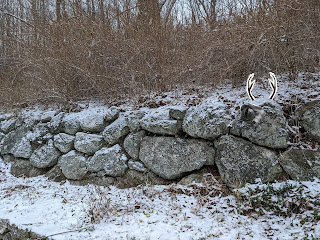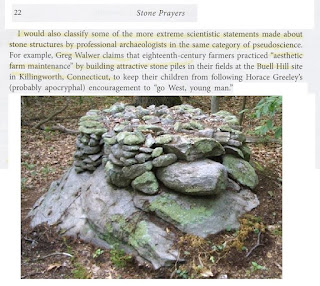Sunday, December 24, 2023
Winter Solar Standstill (Nonnewaug)
Monday, December 18, 2023
Colonialist Armchair Investigation
I can’t remember the
term for the term of a term which one has just suddenly invented at the moment,
but here’s the phrase: Colonialist Armchair Investigation. My longtime
associate Mr. Peter Waksman knows just what I mean I know because he has
alluded to the phenomenon as well, all those times when he’s said that some of
these “Indians never built in stone in New England” Denialists need to get out
of their armchairs and “take to the woods” and take a look around.
But neither Peter nor I were the first to say
something like that.
Here’s what Dr. Bruce
G. Trigger had to say about something like that:
The name of the
region where Peter and I found ourselves wandering about in, looking for
stacked stone features, is known as New England. If I say instead that we’ve
been making observations of Indigenous Stonework at “The Eastern Gate of Turtle
Island,” most people (from their armchairs) would not have a clue where we were
talking about. Right away, one has to use the Colonialist term, the “New
England,” to even begin a discussion of where we are investigating which.
The second category, colonialist archaeology, refers to
archaeology practiced by colonizers in a colonized country. Examples show that
colonial archaeologists often emphasized the primitiveness or lack of
accomplishments of the ancestors of colonized people to justify discriminatory
behavior as well as colonization itself. The United States, New Zealand, and
parts of sub-Saharan Africa are examples of countries and regions that
experienced periods of colonialist archaeology.
Third, Trigger pointed out that states with worldwide
political, economic, and cultural power have produced imperialist
archaeological traditions. He included in this category the archaeological
traditions of the United Kingdom, the Soviet Union, and the United States after
the advent of processual archaeology. Archaeologists working within an
imperialist tradition take for granted the superiority and universal
applicability of their theoretical and methodological approaches. They also
exert a strong influence on research around the world through their writings,
the international nature of their research projects, and the key role they play
in training archaeologists from various parts of the world..."
https://anthropology.berkeley.edu/sites/default/files/habu_multiple_narrtatives.pdf
: "Nationalist, Colonialist, and Imperialist
Archaeologies that claim most of the credit for the majority of an
incredible amount of stonework may well be the sort of “Alternative Archaeology”
or Pseudoscience that cherry picks a small bit of documentation for a small
amount of stonework, as if Denialism is science with no need for further
investigation."
Nationalist, Colonialist, and Imperialist Archaeologies are also “Alternative Archaeologies.”
It’s like, Indians of the Hemisphere were doing things with
earth and shell and stone.
Everywhere else but not Here in my Town and all around New
England,
Those Indians didn’t build anything except campfire hearths
with stones until the Europeans came in and “learned them how.”
And except of course for and Gazillions Gazillions of
Projectile Points.
And those hammerstones and net weights.
And all those fishweirs – on dryland no clue how to stack a
stone on another,
But stick some Indians in some water 3000 years ago...
One might ask: What is nationalist archaeology?
"Nationalism and archaeology have been closely related since at least the nineteenth century. Archaeological interpretations and ancient history can be manipulated for nationalist purposes, such as cultivating national mythologies and national mysticism," writes Mr. Wikipedia.
Friday, December 15, 2023
Jipji'jk “moon of the wintertime” and the "Huron Carol"
I’ve heard that stories in general, and stories about the Big Snake Being or Horned Serpent in particular, aren’t (and “weren’t”) told until the Winter Solstice occurs. A person shouldn’t even speak the name of the Great Serpent until that solar event.
Jean de Brébeuf wrote the lyrics, in the
native language of the Huron/Wendat people, probably in 1642. He probably had
help with those words from First Nations language speakers.
This
morning, some of those words caught my eye in a very different way than they
ever had before…
“Na kesikewiku'sitek jipji'jk*
majita'titek
It was in the moon of the wintertime when all the birds had fled
Kji-Niskam
petkimasnika ansale'wilitka
That mighty Gitchi Manitou sent
angels…”
"Jesous
Ahatonhia" ("Jesus, he is born")
The "Huron Carol" (or "Twas
in the Moon of Wintertime")
*The Mi'kmaw word
"sisipk" is preferred by many to "jipji'jk"
for "birds".
https://firstnationhelp.com/huron.html
Jipijka'm:
The plural form of their name is Jipijkamak or Jipijkmak,
and the female form is Jipijkamiskw or Jipijkamiskwa.
Alternate
spellings: Jupijkám, Tcipitckaam, Chipitchkam, Chepitchcalm, Kchi
Pitchkayam, Ktchi Pitchkaam, Chepechcalm, Chepichkaam, Chepitchkaam,
Che-Pitch-Calm, Chepichealm, Jibichkam, Jipijkma, Chepitkam, Ktchi-Pitchkayam
Pronunciation: chih-pitch-kawm
Also known as: The plural form of their name is Jipijkamak or Jipijkmak, and the female form is Jipijkamiskw or Jipijkamiskwa.
http://www.native-languages.org/jipijkam.htm
Mi'kmaq (Mi'kmaw, Micmac, Mikmaq, Mikmak) Language: “The
Mi'kmaq language, Mi'kmawi'simk, is
an Algonquian language spoken by 8000 Indians in the Canadian Maritimes
(particularly Nova Scotia) and a few US communities in the Northeast. The
Mi'kmaq dialect spoken in Quebec is called Restigouche (or Listuguj) and can be
hard for other native speakers to understand.”
http://www.native-languages.org/mikmaq.htm
"Na kesikewiku'sitek sisipk Majita'titek,
Majita'titek, Kji-Niskam petkimasni…"
jipjl'j n., bird
jipijka'm: crocodile (!), • Mi'kmaw-English Lexicon page 80
Kesikewiku's/Kjiku's: “December;
the great month”
kaqtukow, kaqtukwew n., thunder
sislp: “bird”
snake: mte'skm
snake (a horned) serpent:
jipijka'm
Grandfather (my)
(traditional form); my father-in-law (contemporary form): niskamij
God: Niskam
https://naig2023.com/wp-content/uploads/education/Mi_kmaq_Lexicon.PDF
Monday, December 04, 2023
Our Vanishing Ceremonial Stone Landscapes (Watertown CT)
Qusukqaniyutôkansh (pl): Rows of Stacked Stones,
colloquially “stone walls” or “stone
fences,” often assumed to be post contact constructions related to property
ownership and agriculture.
Qusukqaniyutôk (2023): “A row of stones artistically stacked
or laid using elements of Indigenous Iconography, sometimes obviously resembling
a Great Snake, often composed of smaller snake effigies as well as other effigies
both zoomorphic and anthropomorphic, sometimes appearing to shapeshift into
another effigy, possibly related to control of water or fire (sometimes both) on
Sacred Cultural Landscapes that are beginning to be recognized as Indigenous Ceremonial
Stone Landscapes.”
From a perspective of distance, the largest of the Stone Snake
Qusukqaniyutôk snake across the
landscape, crossing over others, sometimes connecting great boulders or bedrock
outcrops, sometimes along streams – and sometimes stacked over and hiding a
stream, a Musical Row of Stones - the sound of water is the Great Snake
contentedly “purring.”
Inside some enclosures, there were “gardens,” plant
resources perhaps tended by fire, perhaps protected from fire, something living
kept in balance, kept in production by someone offering tobacco to a serpent
guardian before entering, someone singing while stacking stones, picking up and
replacing her grandmothers’ and grandfathers’ stones that have fallen.
Sometimes zigzag rows of stones, sometimes linear rows of stones, sometimes snaking across the landscape, sometimes along both sides of an Indian Path or Native American Trail or an Indigenous Road that could possibly be two or ten or twelve thousand years old.
Sometimes torn from the landscape in the blink of an eye, sometimes gone forever, sometimes never to snake across the landscape again…
Sometimes I feel I'm just documenting
Our Vanishing Ceremonial Stone Landscapes
Qusukqaniyutôk: (‘stone row, enclosure’ Harris and Robinson, 2015:140,
‘fence that crosses back’ viz. qussuk, ‘stone,’ Nipmuc or quski, quskaca,
‘returning, crosses over,’ qaqi, ‘runs,’ pumiyotôk, ‘fence, wall,’ Mohegan,
Mohegan Nation 2004:145, 95, 129) wall (outdoor), fence, NI – pumiyotôk plural
pumiyotôkansh.) - Nohham Rolf Cachat-Schilling
Bulletin of the Massachusetts Archaeological Society, Vol. 77, No. 2 Fall
2016
https://vc.bridgew.edu/cgi/viewcontent.cgi?article=1202&context=bmas
Sunday, December 03, 2023
Small Children , Small Stone Prayers, Small Turtle Effigies (CT)
By the Old Chickenyard (Nonnewaug)
“Historically, archaeologists have devoted few resources to understanding the social roles and activities of children...Lucy (2005) attributes part of the problem to the unwillingness of many archaeologists to include children in their interpretations unless there is direct evidence, usually mortuary, of a child's presence…" From: Playing with method: testing one approach towards identifying the places of past children -Mackenzie Cory (2020)
Above: The decaying coop, farm junk, and snow, covering low cairn-like Káhtôquwukansh or "Stone Prayers..."
"Playing with method: testing one approach towards identifying the places of past children"
Published online by Cambridge University Press: 14 December 2020
Friday, December 01, 2023
Another Eye Test (RI)
Sunday, November 26, 2023
Call it vandalism, because, “It’s just a Rock”
I love to get lost in a bunch of photos from places I’ve never been.
My knees may be
screaming while I’m sitting watching the sunrise out my windows, but I’m
virtually walking somewhere I’ve never been sometimes by looking at other
peoples’ photos.
This morning, I started here:
And wandered over to here:
Now keep in mind that many a Split Boulder is sometimes known as:
A pettutéaonk, a "portal,"
or a “place of passage between layers of the world”
- In the Lënape language: pindaxsenakan (tobacco pouch, petu+hassen+ikun, “device for entering stone;”
And then, importantly, petouwassinug, in Narragansett; (Trumbull 1903:124).”
-
Call it vandalism,
because, “It’s just a Rock”
Call it something harsher if it is not…
Split-filled Boulders: "A total of 386 sites contained
split-filled boulders. A possible Algonquian term for this type is
pindaxsenakan - literally, "a living being enters into something," on
the idea that these were considered spirit portals to the underworld," Dr.
Curtiss Hoffman writes in “Stone Prayers” (2018).
https://www.arcadiapublishing.com/Products/9781634990493
https://www.facebook.com/narragansettrocks





























.jpg)





















